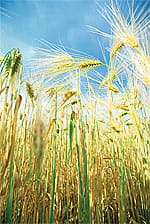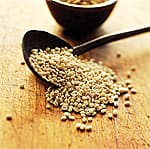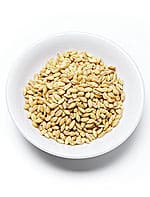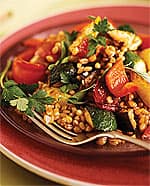Life Extension Magazine®
Barley may be one of the oldest grains on earth, having first been used by the Egyptians 10,000 years ago and later brought to America by Christopher Columbus in 1494. Despite its long history, barley has not gained the same popularity as a dietary staple in the US as wheat or oats.1 Now, as the medical community unearths more and more exciting health benefits of consuming barley, this fact may soon change. Rich in phytochemicals, fiber, and minerals that ward off a plethora of diseases, substituting your usual grain of choice with barley may confer an array of health benefits, ranging from balanced blood sugar levels to protection against cardiovascular disease and cancer. Keeping Blood Sugar Levels BalancedIn barley's arsenal of components that make it a healthful superfood, the blockbuster stand-out is a particular kind of soluble fiber called beta-glucan. Similar to another fiber called pectin in consistency, beta-glucan is a viscous fiber that our bodies can't digest. By binding with water, beta-glucan slows the rate that food moves through the digestive system, tempering the body's glucose and insulin responses after a meal.2 While beta-glucan is present in the cell walls of barley, oats, yeast, bacteria, algae, and mushrooms, barley and oats are the richest sources of beta-glucan among the grains.3 Yet emerging evidence suggests that barley might be even more beneficial than oats when it comes to modulating blood sugar. In fact, in one study comparing the insulin and glucose response in overweight women to barley and oats, researchers actually found "peak glucose and insulin levels after barley were significantly lower than those after glucose or oats." The researchers tested a variety of forms of the grains (from oat flour and oatmeal to barley flour and barley flakes) and discovered that while the particle size had little effect on the glycemic responses, "the high soluble fiber content of this barley appeared to be a factor in the greater reduction observed."4 This is exciting news not just for those who suffer from diabetes. It also shows barley's promising effects on anyone who's at risk for metabolic syndrome.
Thwarting Heart DiseaseStudies suggest that barley can lessen your risk of cardiovascular diseases by hindering the amount of cholesterol absorbed by the intestines. Cardiovascular disease prevention is an established benefit of whole-grain fiber intake. Again, the soluble fiber called beta-glucan in barley appears to be the secret weapon. Beta-glucan likely acts via numerous mechanisms to promote healthy blood lipid levels. By increasing the volume and viscosity of the intestinal contents, beta-glucan may help reduce the amount of dietary cholesterol absorbed through the intestinal epithelium. Beta-glucan also increases the excretion of bile acids into the intestines. Since oxidized cholesterol comprises bile acids, this has the net effect of lowering serum cholesterol levels.5
Increasing dietary intake of beta-glucan helps to lower low-density lipoprotein (LDL) as well as total cholesterol in men and women.6,7 Barley appears to be more effective in lowering blood cholesterol than other whole grains like wheat and rice because of its high beta-glucan content.7-11 One study found that moderately hypercholesterolemic subjects who consumed 3 or 6 grams of beta-glucan from barley demonstrated decreased levels of total cholesterol. Men and postmenopausal women derived the greatest benefits from beta-glucan.12 Barley has also been shown to lower blood pressure, an important risk factor for cardiovascular disease and stroke. One five-week study found that men who replaced 20% of their energy intake with whole grains like barley experienced reductions in systolic, diastolic, and mean arterial pressure.13 The FDA has determined that foods containing barley may now carry a qualified health claim that they reduce the risk of coronary heart disease when combined with a diet low in cholesterol and saturated fat. Whole-grain barley and dry milled barley products must contain at least 0.75 grams of soluble fiber per serving in order to make this health claim.14 A research meta-analysis determined that each 10 gram increase in total dietary fiber intake produced a 14% reduction in all coronary events and a 27% decrease in the risk of coronary death.15 Cancer ProtectionBarley is also rich in phytonutrients known as lignans, compounds that appear to help ward some cancers.16 Specifically, the dominant lignan that occurs naturally in barley is called 7-hydroxymatairesinol.16 Lignans appear to have a protective effect against some cancers because they are metabolized by beneficial bacteria in the colon into enterolactone and enterodiol, two substances that have mild estrogen-like effects.17 Increasing dietary intake of whole grains represents an important strategy to boost serum levels of enterolactones.18,19 An important German study found that women with the highest plasma levels of enterolactone had a remarkable 62% lower risk of premenopausal breast cancer, compared with women with the lowest plasma levels.20 Men may similarly benefit from increasing their dietary intake of lignans. A study analyzing blood enterolactone levels in men with prostate cancer versus healthy controls found that men with the highest enterolactone levels were 82% less likely to have prostate cancer.21 Keeping high blood levels of enterolactones by upping your intake of barley and other whole grains could thus help thwart cancers, particularly hormone-dependent cancers.
Gastrointestinal Health BenefitsBarley is a rich source of both soluble and insoluble fiber, both of which may benefit gastrointestinal health. The insoluble fiber found in barley binds with water to add bulk to stools, thus promoting more regular bowel movements.22 Some of the soluble fiber found in barley is digested by colonic bacteria to produce short-chain fatty acids, which may help promote bowel health.22 In fact, germinated barley products are undergoing investigation for their ability to help soothe colonic mucosa in the painful inflammatory bowel disease known as ulcerative colitis.23 Enjoying BarleyBarley is available in numerous forms, including hulled barley kernels, flakes, grits, pearls, and ground flour. Whole-grain barley kernels contain more fiber and nutrients than the more common pearled barley. Pearled barley is smoother because it's been scrubbed clean of the healthful outer husk and bran layer in the refining process. Hulled barley not only has retained all the nutrients in the outer husk and bran layer, but it also has a nuttier flavor. Hulled barley requires a longer cooking time than pearled barley, however. Pearled barley is still an excellent dietary choice, providing 3 grams of fiber per ½ cup serving, compared with only 1.75 grams of fiber in ½ cup of long-grain brown rice.24 Nutrient powders rich in beta-glucans are also available.
Store uncooked barley in an airtight container in a cool place. Add cooked barley kernels to soups, stews, salads, and casseroles. Substitute cooked barley kernels or pearls for rice in your favorite recipe. Cooked barley flakes or grits make a delicious hot cereal similar to oatmeal. Substitute some of the white or wheat flour in baked breads and desserts with barley flour to add flavor and fiber. ConclusionBarley's amazing properties make it no surprise that this grain would have endured for millennia. But what is striking is the fact that Americans have been slow to embrace barley as they have wheat, corn, rice, and oats. Fortunately, as new research unveils more and more ways that barley can be a healthful addition to your diet, it will become a more pervasive staple to our diets. And check out the recipe on this page from the National Barley Foods Council. At just under 300 calories per serving, this salad is worth making tonight! If you have any questions on the scientific content of this article, please call a Life Extension Health Advisor at 1-800-226-2370.
| |||||||||||||||||||||||||||||||||||||||||||
| References | |||||||||||||||||||||||||||||||||||||||||||
| 1. Available at: http://www.aaccnet.org/cerealfoodsworld/samplepdfs/CFW-51-0004.pdf. Accessed August 11, 2008. 2. Granfeldt Y, Liljeberg H, Drews A, Newman R, Bjorck I. Glucose and insulin responses to barley products: influence of food structure and amylose-amylopectin ratio. Am J Clin Nutr. 1994 May;59(5):1075-82. 3. Behall KM, Scholfield DJ, Hallfrisch JG, Liljeberg-Elmstahl HG. Consumption of both resistant starch and beta-glucan improves postprandial plasma glucose and insulin in women. Diabetes Care. 2006 May;29(5):976-81. 4. Behall KM, Scholfield DJ, Hallfrisch J. Comparison of hormone and glucose responses of overweight women to barley and oats. J Am Coll Nutr. 2005 Jun;24(3):182-8. 5. Leinonen KS, Poutanen KS, Mykkanen HM. Rye bread decreases serum total and LDL cholesterol in men with moderately elevated serum cholesterol. J Nutr. 2000 Feb;130(2):164-70. 6. Behall KM, Scholfield DJ, Hallfrisch J. Effect of beta-glucan level in oat fiber extracts on blood lipids in men and women. J Am Coll Nutr. 1997 Feb;16(1):46-51. 7. Keenan JM, Goulson M, Shamliyan T, et al. The effects of concentrated barley beta-glucan on blood lipids in a population of hypercholesterolaemic men and women. Br J Nutr. 2007 Jun;97(6):1162-8. 8. Lupton JR, Robinson MC, Morin JL. Cholesterol-lowering effect of barley bran flour and oil. J Am Diet Assoc. 1994 Jan;94(1):65-70. 9. Behall KM, Scholfield DJ, Hallfrisch J. Diets containing barley significantly reduce lipids in mildly hypercholesterolemic men and women. Am J Clin Nutr. 2004 Nov;80(5):1185-93. 10. Behall KM, Scholfield DJ, Hallfrisch J. Lipids significantly reduced by diets containing barley in moderately hypercholesterolemic men. J Am Coll Nutr. 2004 Feb;23(1):55-62. 11. Adam A, Lopez HW, Tressol JC, et al. Impact of whole wheat flour and its milling fractions on the cecal fermentations and the plasma and liver lipids in rats. J Agric Food Chem. 2002 Oct 23;50(22):6557-62. 12. Available at: http://www.ars.usda.gov/research/publications/publications.htm?seq_no_115=185932. Accessed August 8, 2008. 13. Available at: http://www.ars.usda.gov/research/publications/publications.htm?SEQ_NO_115=139663. Accessed August 8, 2008. 14. Available at: http://www.fda.gov/bbs/topics/NEWS/2006/NEW01375.html. Accessed August 11, 2008. 15. Pereira MA, O'Reilly E, Augustsson K, et al. Dietary fiber and risk of coronary heart disease: a pooled analysis of cohort studies. Arch Intern Med. 2004 Feb 23;164(4):370-6. 16. Smeds AI, Eklund PC, Sjoholm RE, et al. Quantification of a broad spectrum of lignans in cereals, oilseeds, and nuts. J Agric Food Chem. 2007 Feb 21;55(4):1337-46. 17. Thompson LU. Experimental studies on lignans and cancer. Baillieres Clin Endocrinol Metab. 1998 Dec;12(4):691-705. 18. Jacobs DR Jr, Pereira MA, Stumpf K, Pins JJ, Adlercreutz H. Whole grain food intake elevates serum enterolactone. Br J Nutr. 2002 Aug;88(2):111-6. 19. Johnsen NF, Hausner H, Olsen A, et al. Intake of whole grains and vegetables determines the plasma enterolactone concentration of Danish women. J Nutr. 2004 Oct;134(10):2691-7. 20. Piller R, Chang-Claude J, Linseisen J. Plasma enterolactone and genistein and the risk of premenopausal breast cancer. Eur J Cancer Prev. 2006 Jun;15(3):225-32. 21. Hedelin M, Klint A, Chang ET, et al. Dietary phytoestrogen, serum enterolactone and risk of prostate cancer: the cancer prostate Sweden study (Sweden). Cancer Causes Control. 2006 Mar;17(2):169-80. 22. Trepel F. Dietary fibre: more than a matter of dietetics. I. Compounds, properties, physiological effects. Wien Klin Wochenschr. 2004 Jul 31;116(14):465-76. 23. Bamba T, Kanauchi O, Andoh A, Fujiyama Y. A new prebiotic from germinated barley for nutraceutical treatment of ulcerative colitis. J Gastroenterol Hepatol. 2002 Aug;17(8):818-24. 24. Available at: http://www.barleyfoods.org/nutrition.html. Accessed August 8, 2008. 25. Hallfrisch J, Facn, Behall KM. Mechanisms of the effects of grains on insulin and glucose responses. J Am Coll Nutr. 2000 Jun;19(3 Suppl):320S-5S. 26. Available at: http://www.mypyramid.gov/pyramid/grains_why_print.html. Accessed August 8, 2008. 27. Available at: http://www.sciencedaily.com/releases/2007/05/070509161030.htm. Accessed August 8, 2008. 28. Liu S, Manson JE, Stampfer MJ, et al. A prospective study of whole-grain intake and risk of type 2 diabetes mellitus in US women. Am J Public Health. 2000 Sep;90(9):1409-15. 29. Fung TT, Hu FB, Pereira MA, et al. Whole-grain intake and the risk of type 2 diabetes: a prospective study in men. Am J Clin Nutr. 2002 Sep;76(3):535-40. 30. Available at: www.nal.usda.gov/fnic/foodcomp/cgi-bin/list_nut_edit.pl. Accessed August 8, 2008. | |||||||||||||||||||||||||||||||||||||||||||




